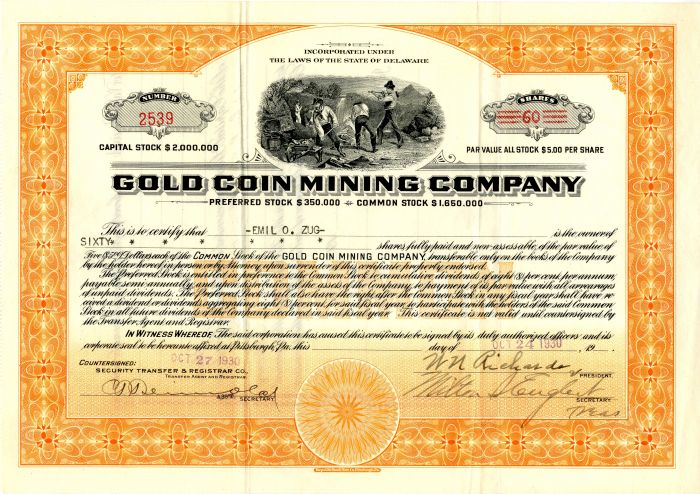Gold Coin Mining Co. - Stock Certificate
Inv# MS2959 Stock
Montana
Stock printed by Republic Bank Note Co., Pittsburgh, Pa. Missoula, Montana.
Archaeological artifacts date the earliest inhabitants of the Missoula Valley to 12,000 years ago with settlements as early as 3500 BCE. From the 1700s until 1850s, those who used the land were primarily, the Salish, Kootenai, Pend d'Oreille, Blackfeet, and Shoshone. Located at the confluence of five mountain valleys, the Missoula Valley was heavily traversed by local and distant native tribes that periodically went to the Eastern Montana plains in search of bison. This led to conflicts. The narrow valley at Missoula's eastern entrance was so strewn with human bones from repeated ambushes that French fur trappers later referred to this area as Porte de l'Enfer, translated as "Gate of Hell". Hell Gate would remain the name of the area until it was renamed "Missoula" in 1866.
The Lewis and Clark Expedition brought the first U.S. citizens to the area. They twice stopped just south of Missoula at Traveler's Rest. They camped there the first time on their westbound trip in September 1805. When they stayed there again, on their return in June–July 1806, Clark left heading south along the Bitterroot River and Lewis traveled north, then east, through Hellgate Canyon. In 1860, Hell Gate Village was established 5 miles (8 km) west of present-day downtown by Christopher P. Higgins and Frank Worden as a trading post to serve travelers on the recently completed Mullan Road, the first wagon road to cross the Rocky Mountains to the inland of the Pacific Northwest. The desire for a more convenient water supply to power a lumber and flour mill led to the movement of the settlement to its modern location in 1864.
The Missoula Mills replaced Hell Gate Village as the economic power of the valley and replaced it as the county seat in 1866. The name "Missoula" came from the Salish name for the Clark Fork River, nmesuletkw, which roughly translates as "place of frozen water". Fort Missoula was established in 1877 to help protect further arriving settlers. Growth accelerated with the arrival of the Northern Pacific Railway in 1883, and by charter, Missoula incorporated a municipal government as a town, the same year. In 1885, Missoula reincorporated its government as a city.
In 1893, Missoula was chosen as the location for the first state university, the University of Montana. The need for lumber for the railway and its bridges spurred the opening of multiple saw mills in the area, and in turn, the beginning of Missoula's lumber industry, which remained the mainstay of the area economy for the next 100 years. The United States Forest Service work in Missoula began in 1905. Missoula is also home of the smokejumpers' headquarters and will be the site of the National Museum of Forest Service History. Nationally, there are nine Forest Service regions; Region 1 is headquartered in Missoula.
Logging remained a mainstay of industry in Missoula with the groundbreaking of the Hoerner-Waldorf pulp mill in 1956, which resulted in protests over the resultant air pollution. An article in Life 13 years later speaks of Missoulians sometimes needing to drive with headlights on during the day to navigate through the smog. In 1979, almost 40% of the county labor income still came from the wood and paper-products sector. The lumber industry was hit hard by the recession of the early 1980s and Missoula's economy began to diversify. By the early 1990s, the disappearance of many of the region's log yards, along with legislation, had helped clean the air dramatically.
As of 2009, education and healthcare were Missoula's leading industries; the University of Montana, Missoula County Public Schools, and the two hospitals in the city were the largest employers. St. Patrick Hospital and Health Sciences Center, founded in 1873, is the region's only Level II trauma center and has undergone three major expansions since the 1980s. Likewise, the University of Montana grew 50% and built or renovated 20 buildings from 1990–2010. These industries, as well as expansions in business and professional services, and retail are expected to be the main engines of future growth.
A stock certificate is issued by businesses, usually companies. A stock is part of the permanent finance of a business. Normally, they are never repaid, and the investor can recover his/her money only by selling to another investor. Most stocks, or also called shares, earn dividends, at the business's discretion, depending on how well it has traded. A stockholder or shareholder is a part-owner of the business that issued the stock certificates.










Ebay ID: labarre_galleries